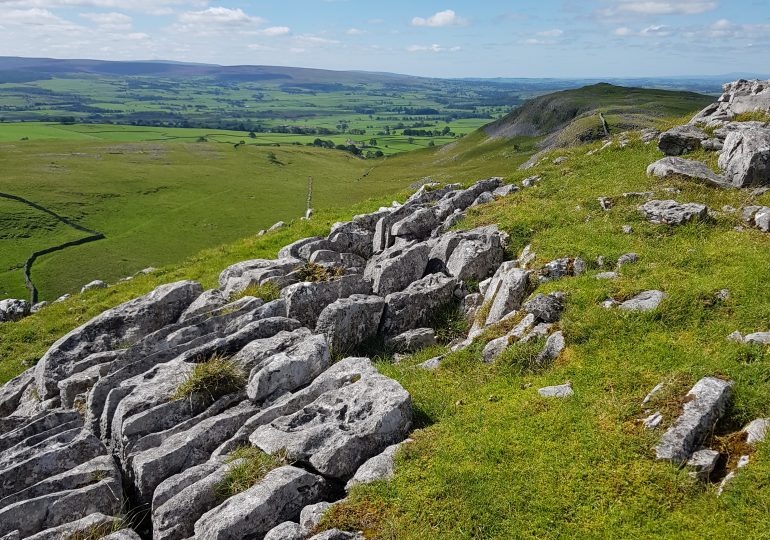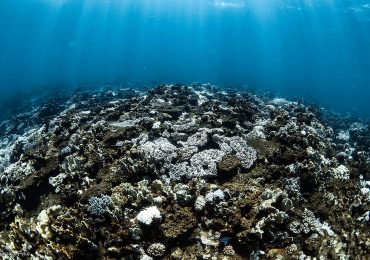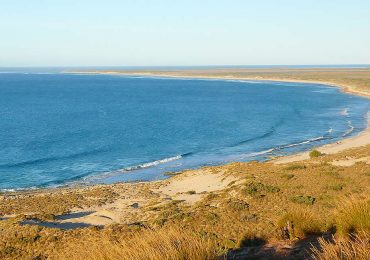In this blog post Carly Stevens, professor at University of Lancaster, presents her work ‘Large changes in vegetation composition seen over the last 50 years in British limestone pavements’. She shares her motivation behind surveying all limestone pavements in Great Britain, presents the conservation challenges faced by this habitat, and encourages every ecologist to go into the field to collect data.
About the paper
Limestone pavements are a natural rocky habitat found in a number of regions across the world. They were formed during glaciation when glaciers scraped away leaving exposed areas of limestone. These have weathered, leaving behind a habitat made up of a regular pattern of blocks of rock (clints) with deep cracks between them (grikes). In Great Britain there are around 28 km2 of limestone pavement and they are highly valued for conservation with many protected in national nature reserves and sites of special scientific interest.
Back in the early 1970’s Stephen Ward and David Evans undertook the first national survey of limestone pavements. Over a period of three years, they visited 537 limestone pavements and recorded the vegetation they found there. This seminal piece of work was important in the later introduction of limestone pavement protection orders and the individual protection of many pavements. While small parts of the survey had been repeated in the intervening period, nobody had repeated the whole survey, and yet this seemed essential to provide a national picture of the conservation and management of this important habitat.
I first encountered the survey in 2015 and was excited at the prospect of repeating it. However, at the time I was 8 months pregnant so it had to wait. When I returned from maternity leave, I started fieldwork, visiting each pavement and recording the vegetation using the same methods as Stephen and David. It was an amazing experience, visiting some incredibly beautiful places and during the course of the project I fell in love with limestone pavements. I did begin to wonder if I had bitten off a bit too much at times and in the end the survey took me five field seasons. When I finished, I wasn’t sure if it was a cause for celebration or not – I was happy with what I had achieved, but sad not to have a reason to keep visiting pavements.
Building upon the original 1970s survey, this paper represents the first national level analysis of vegetation change in limestone pavements. Despite their importance for conservation there has been surprisingly little research on limestone pavements and how we should best manage them. That means this paper is relevant not only to ecologists, but also conservation practitioners.
About the research
Our natural and semi-natural ecosystems are changing due to a whole host of drivers including land-use change, climate change and air pollution. Understanding the impacts of these drivers on the environment requires us to understand how habitats are changing over time. This paper is focused on limestone pavements, but it contributes to this broader picture.
Collecting the data for this study was a great experience but it was also challenging – limestone pavements can be dangerous places with every step creating the potential to put your foot down a grike or trip over a loose rock. They are also very often at the top of hills, so I soon got fitter doing this work. One of the main challenges was the British weather – limestone can become very slippery when wet and so trying to pick your way over the pavements in heavy rain is especially hazardous. There were times when low cloud, heavy rain and surprisingly low temperatures did make the work unpleasant, and others when the weather was so bad I had to cancel, but when the cloud lifted it gifted me with stunning scenery and amazing views. There was, without doubt, a lot of rain but I also had times when it was hot and dry and I had to coat myself in sun cream and plants were wilting in the grikes. Lots of people helped me to collect data and they had to endure the rain too, but it was great to share the pavements with them and see their reactions to seeing them for the first time. Another pleasure was meeting the farmers, I met some lovely people, many of whom care about these landscapes as much as I do.
There were times when I visited pavements and was pleasantly surprised because they had improved or because I found rare species that weren’t recorded on the site in the 1970s. But there were also times when I visited pavements and was disappointed to find they had degraded considerably since the 1970’s or had even, on a small number of occasions, being quarried. Although I had visited all of the pavements myself when I analysed the data, I was surprised by how much tree cover had increased in some limestone pavements. This aspect of the project was time consuming and collecting images from the archive sometimes took weeks. Even having been through this process I was surprised how high some of the increases in tree cover were. All of the pavements surveyed were classed as open by Stephen and David when they originally surveyed them in the 1970s, but by the time I visited there was no question that some of them are wooded now.
This leads us to one of the questions for the future – where pavements have become wooded, should the trees and scrub be cleared, or should we be managing them as wooded pavements now? In fact, there are an awful lot of questions around management and restoration of limestone pavements. There haven’t been any academic studies published regarding management of limestone pavements and there are only small numbers from other parts of the world. I think the next step is collating evidence that can be used to provide the evidence base needed to ensure we manage these habitats appropriately.
About the author
Ecology and the workings of the natural world have fascinated me since I was a child – science and the environment were my interests even from primary school. I did a degree in Environmental Life Science and a Masters in Environmental Science before undertaking a PhD at The Open University looking at the impacts of nitrogen deposition on acidic grasslands. This is where I realised that fieldwork was my real passion and I spent many months travelling around the British uplands. As someone who can never remember people’s names I was surprised that plant names came to me so easily, but I have been very lucky to learn from some amazing botanists throughout my career, including my PhD supervisor Owen Mountford.
I am now Professor of Plant Ecology and Soil Biogeochemistry at Lancaster University where I am also fortunate enough to currently hold a NERC Knowledge Exchange Fellowship focussed on the conservation of limestone pavements. My fellowship was inspired by the Floodplain Meadows Partnership run by David Gowing and aims to build partnerships between academics and practitioners. It can be hard to get funding for applied ecology, and the research presented in this paper was funded through a series of small fieldwork grants, but over time I was able to build that into a larger project. Since fieldwork is my first love I didn’t mind that I had to do all the work myself instead of hiring a post doc to do it, in fact, my main advice to someone in my position would be, don’t give up doing fieldwork and collecting your own data as you advance in your career.
Like the blog post? Read the research article here.
Leave a comment






